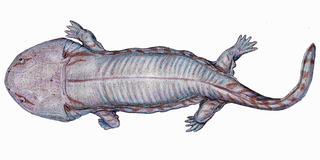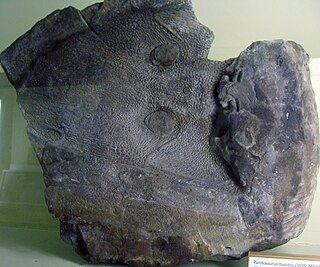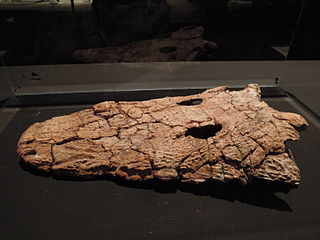
Temnospondyli or temnospondyls is a diverse ancient order of small to giant tetrapods—often considered primitive amphibians—that flourished worldwide during the Carboniferous, Permian and Triassic periods, with fossils being found on every continent. A few species continued into the Jurassic and Early Cretaceous periods, but all had gone extinct by the Late Cretaceous. During about 210 million years of evolutionary history, they adapted to a wide range of habitats, including freshwater, terrestrial, and even coastal marine environments. Their life history is well understood, with fossils known from the larval stage, metamorphosis and maturity. Most temnospondyls were semiaquatic, although some were almost fully terrestrial, returning to the water only to breed. These temnospondyls were some of the first vertebrates fully adapted to life on land. Although temnospondyls are amphibians, many had characteristics such as scales and large armour-like bony plates (osteoderms) that generally distinguish them from the modern soft-bodied lissamphibians.

Mastodonsaurus is an extinct genus of temnospondyl from the Middle Triassic of Europe. It belongs to a Triassic group of temnospondyls called Capitosauria, characterized by their large body size and presumably aquatic lifestyles. Mastodonsaurus remains one of the largest amphibians known, and may have exceeded 6 meters in length.

Rhinesuchus is a large temnospondyl. Remains of the genus are known from the Permian of the South African Karoo Basin's Tapinocephalus and Cistecephalus assemblage zones, both belonging to the Beaufort Group. The skull of Rhinesuchus had a flat triangular shape with blunt snout similar to some of the other large temnospondyls, and had a palate filled with small sharp teeth, suggesting that it hunted fish. Also, the small eyes were on top of the head suggesting that it approached its prey from below.

The Stereospondyli are a group of extinct temnospondyl amphibians that existed primarily during the Mesozoic period. They are known from all seven continents and were common components of many Triassic ecosystems, likely filling a similar ecological niche to modern crocodilians prior to the diversification of pseudosuchian archosaurs.

Parotosuchus is an extinct genus of capitosaurian temnospondyls within the family Mastodonsauridae. Fossils are known from the Early Triassic of Europe, Africa, Australia, and Antarctica. It was about 2 metres (6.6 ft) long and likely lived in aquatic environments such as lakes and rivers. Parotosuchus was covered in a scaly skin, unlike the smooth skin of modern-day amphibians, and probably moved with an eel-like motion in the water.

Eryosuchus is an extinct genus of capitosauroid temnospondyl from the Middle Triassic of northern Russia. It was a very large predator: the largest specimen known could reach up to 3.5 m (11.5 ft) in length, with a skull over 1 m long.

Intasuchus is an extinct genus of temnospondyl amphibian from the Middle Permian of Russia. It is known from a single species, Intasuchus silvicola, which was named in 1956. Intasuchus belongs to the family Intasuchidae and is probably its sole member, although other taxa such as Syndyodosuchus and Cheliderpeton have been assigned to the family in the past. Intasuchus most likely belongs to the group Archegosauroidea, Permian relatives of the large, mostly Mesozoic temnospondyl clade Stereospondyli.

Trematosaurus is an extinct genus of trematosaurid temnospondyl amphibian found in Germany and Russia. It was first named by Hermann Burmeister in 1849 and the type species is Trematosaurus brauni.

Dvinosaurus is an extinct genus of amphibious temnospondyls localized to regions of western and central Russia during the middle and late Permian, approximately 265-254 million years ago. Its discovery was first noted in 1921 by Russian paleontologist Vladimir Prokhorovich Amalitskii in a posthumously published paper that documents the findings of a site in Russia's Arkhangelsk District. Its name is derived from the proximity of this site to the Northern Dvina River.

Konzhukovia is an amphibian genus that belongs to an extinct family Konzhukoviidae of temnospondyls, the largest clade of basal tetrapods including about 198 genera, 292 species, and more than half of which were alive during the early Mesozoic period. The animal was a predator that lived about 260 million years ago, and could get up to about three meters in length. Specifically, Konzukovia lived during the Permian, between 252 and 270 million years ago according to the type of rock the fossil was found in. There are three species within this genus, K. vetusta, K. tarda, and K. sangabrielensis, the first two originating from Russia while the latest originating from Southern Brazil. The discovery of this specimen in Southern Brazil provided more evidence to support the idea that during this animals existence, there was a “biological corridor” because of the supercontinent Pangea, allowing these species to be found so far apart from each other. Konzhukovia belongs to the family Archegosauridae, a family consisted of large temnospondyls that most likely compare to modern day crocodiles. Since the discovery of the latest species, K. sangabrielensis, Pacheco proposes that there must be the creation of a new family, Konzhokoviidae, a monophyletic group in a sister-group relationship with Stereospondlyi in order to accommodate the three species. Konzhukovia skulls usually exhibit typical rhinesuchid features including an overall parabolic shape, small orbits located more posteriorly, and the pterygoids do not reach the vomer. These animals were long-snouted amphibians that had clear adaptations made for fish catching, as well as exemplifying aquatic features.

Benthosuchus is an extinct genus of temnospondyl amphibian from the Early Triassic of Russia. It was primarily aquatic, living in rivers and lakes. Multiple species are known, with the largest reaching about 2.5 meters in length.

Lydekkerinidae is a family of stereospondyl temnospondyls that lived in the Early Triassic period. During this time period, lydekkerinids were widely distributed, with putative remains reported from Russia, Greenland, India, South Africa, Madagascar, Australia, and Antarctica. In contrast to most other stereospondyls, lydekkerinids were relatively small-bodied. The type genus is Lydekkerina, the namesake of the family and the best-known lydekkerinid.
Bukobaja is an extinct genus of mastodonsaurid temnospondyl from the middle Triassic of Russia. It contains a single species, Bukobaja enigmatica. Bukobaja mainly occurs in the Bukobay Svita as part of the Ladinian?-age "Mastodonsaurus fauna", a section of Russian Triassic biostratigraphy characterized by "Mastodonsaurus" torvus. It was also present in the underlying Donguz Svita. Bukobaja appears to be a valid genus similar to, yet distinct from, Mastodonsaurus. Despite appearing to possess several unique features, Bukobaja is still known from very few remains. This has led to difficulties in determining its relations more precisely than "Mastodonsauridae incertae sedis". It has also been compared to trematosaurids.

Bothriceps is an extinct genus of stereospondyl temnospondyl. It is a member of the infraorder Trematosauria and is the most basal brachyopomorph known. It may be the only brachyopomorph that lies outside the superfamily Brachyopoidea, which includes the families Brachyopidae and Chigutisauridae. It shares several similarities to Keratobrachyops, another basal brachyopomorph, and may be closely related to or even synonymous with it.

Lydekkerina is an extinct genus of stereospondyl temnospondyl. It is the type genus of the family Lydekkerinidae. Fossils have been collected from Early Triassic deposits in South Africa and Australia. The type species is L. huxleyi, first described in 1889. While most other stereospondyls were semiaquatic, Lydekkerina was exclusively terrestrial.
Luzocephalus is an extinct genus of temnospondyl from the Early Triassic of Russia and Greenland. It is usually regarded as a member of the family Lydekkerinidae, although it has also been placed in the family Trematosauridae.

Keratobrachyops is an extinct genus of trematosaurian temnospondyl found in the Arcadia Formation of Queensland, Australia. It had been thought to be a basal chigutisaurid but is now thought to be a basal brachyopomorph closely related to the genus Bothriceps, and may even be a synonym of it.

Trematosuchus is an extinct genus of trematosaurian temnospondyl within the family Trematosauridae from South Africa. The type species was first named by Haughton in 1915 as Trematosaurus sobeyi. It was assigned to its own genus, Trematosuchus, by D.M.S. Watson in 1919.

Capitosauria is an extinct group of large temnospondyl amphibians with simplified stereospondyl vertebrae. Mainly living as piscivores in lakes and rivers, the Capitosauria and its sister taxon Trematosauria were the only major labyrinthodonts that existed during the Mesozoic in ecological niches broadly similar to those of modern crocodiles, and some grew to very large sizes. At 6 meters in length, the Mid-Triassic Mastodonsaurus giganteus is not only thought to have been the largest capitosaur, but possibly also the largest amphibian to have lived. The latest known remains are from the Rhaetian of Germany and are referred to Cyclotosaurus.
Selenocara is an extinct genus of mastodonsauroid temnospondyl. The type species is Selenocara groenlandica, described by Gunnar Säve-Söderbergh in 1935 on the basis of skull bones from the Lower Triassic Wordie Creek Formation of Greenland. Säve-Söderbergh originally described it as a new species of Wetlugasaurus.




















